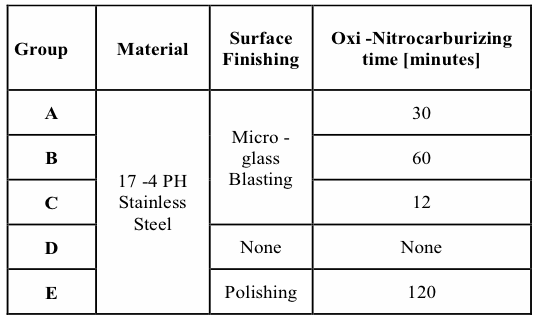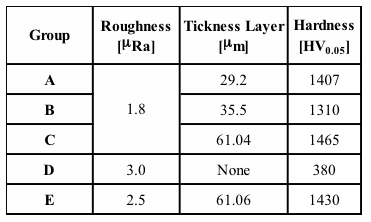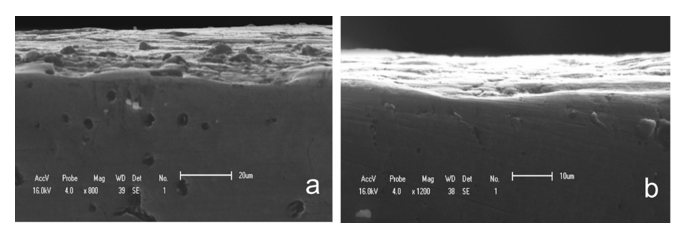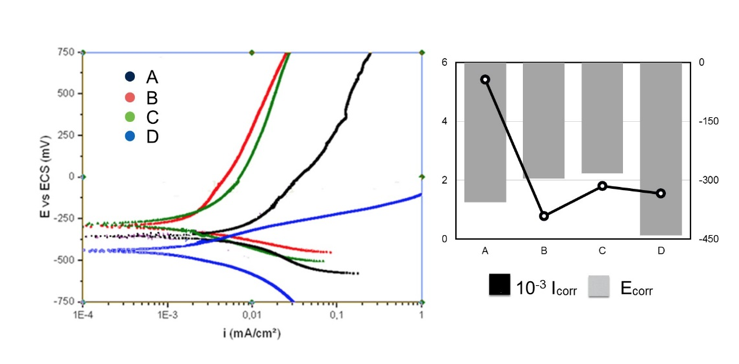

 HOME | ÍNDICE POR TÍTULO | NORMAS PUBLICACIÓN
HOME | ÍNDICE POR TÍTULO | NORMAS PUBLICACIÓN Espacios. Vol. 36 (Nº 20) Año 2015. Pág. 21
Jorge Luis MEDEIROS Braz 1,2; A. REGULY 2; Telmo Roberto STROHAECKER 2
Recibido: 15/09/15 • Aprobado: 01/10/2015
ABSTRACT: In order to increase manufacturing and performance Metal Injection Molding process has been applying for the fabrication of small complex stainless steel parts. Literature have been show that the surface porosity act as detrimental for corrosion behavior for this parts. In this sense, this work evalu-ates the influence of the diffusion time and prior surface finishing during the application of an Oxi-nitrocarburizing Quench-Polish-Quench process in the corrosion performance of 17-4 PH stainless steel materials, manufactured through Metal Injection Molding. The results indicated the benefits pro-vided by the strengthening process in the increasing of corrosion performance. |
RESUMO: A fim de aumentar a produção e desempenho do processo de moldagem por injeção de metal tem vindo a aplicar para a fabricação de pequenas peças de aço inoxidável complexos. Literatura ter sido mostram que a porosidade ato superfície tão prejudicial para o comportamento de corrosão para essas partes. Neste sentido, este trabalho avalia a influência do tempo de difusão e acabamento da superfície antes durante a aplicação de um processo de Quench-polaco Quench Oxi-nitrocarbonetação no des-empenho à corrosão de materiais de aço inoxidável 17-4 PH, fabricados através de Metal Injection Molding. Os resultados indicaram os benefícios proporcionados pelo processo de reforço no aumento da resistência à corrosão. |
Nowadays, globalization leads to competition and demands the search for better efficiency and cost reduction in materials manufacturing. For corrosive applications, Stainless Steels still is the first economic and technological material of choice. Stainless steels are more resistant to rusting and staining than plain carbon and low alloy steels [1,2]. Beside its great performance, manufacturing these materials, in small and complex geometry parts, is always a challenge. Stainless steels are hard to machine, therefore, frequently the parts are manufactured by investment casting. The dimensional restriction faced by casting lead to the application of Powder Metallurgy (PM). Although its advantage, PM provide parts with considerable porosity content, decreasing corrosion and mechanical performance in comparison with conventional production route. In addition, PM can only produce parts with simple shape. In this sense, Metal injection molding (MIM) is a technology that brings together the diversity of PM and geometric freedom of component design associated with thermoplastic injection molding. The combination of these technologies allows complex shape with low cost and high performance applications as showed in Figure 1 [3 - 10].

Figure 1: Examples of complex and small parts manufactured by MIM processes [6, 7].
Beside all the advantages, literature indicated that corrosion resistance of sintered stainless steel parts is directly affected by open porosity. Castro at all [11] compare the corrosion resistance of a 316L stainless steel materials manufactured by MIM, PM and Wrought process. The authors suggested that corrosion behavior of sintered stainless steels is affected by porosity. Once a high open porosity produces an exposure of a larger surface area to the environment, MIM reduces and changes the shape of open pores and, therefore, improves the corrosion resistance.
Simchi and Danninger [12] analysed the porosity influence in the wear of some iron MIM materials. The work indicated that pores also affect the stress and strain distribution in the surface. In order to reduce the porosity effects researchers and engineers has been searching for the development and application of some advanced surface strengthening technology.
Li, at all [13] analysed the influence of the Quench - Polish - Quench complex salt bath process (QPQ) in the performance of 304L austenitic stainless steel parts. The authors established that the corrosion rate could be effectively reduced by the QPQ treatment, and the formation of a compact and integrated magnetite (Fe3O4) film that can improve wear resistance.
In addition, Li, at all [14] analysed the influence of salt bath nitrocarburizing and post-oxidation process on surface microstructure evolution and corrosion behavior of 17-4PH stainless steel, they showed that high micro-hardness values (>1200 HV0.1) were obtained at the surface for both of the nitrocarburized and post-oxidized samples.
Once 17-4 PH is the most widely used MIM stainless steel material, this work aimed for the evaluation of the influence of the Oxi-nitrocarburizing process time and the application of a shot peening intermediate process in the corrosion behavior of 17-4PH stainless steels, manufactured by the combination of MIM and QPQ processes.
This evaluates the benefits of the Oxi-nitrocarburizing processes in the tribological properties of some 17-4PH stainless steel manufactured by the combination of MIM and QPQ processes.
The bulk material Micro-hardness and composition was 380 HV0.05, and 0.04C, 15.3Cr, 3.21Ni, 0.1Si, 0.3Mn, 0.002P, 0.05Mo, 0.21Nb, 0.002Ti, 0.03V (+Fe balance).
The atomized 17-4PH powder were mixed with a polymeric matrix, debinded at 60 °C for
4 hours and pre-sintered at 550 °C for 1 hour in an 100% Nitrogen environment. After, the material was sintered at 1390 °C for 2 hours in a 100% Hydrogen atmosphere. In the next step, the sintered samples were submitted to a solution annealing in a vacuum furnace at 1040 °C for 60 minutes.
After that, the samples were cooled in a Nitrogen atmosphere at 4 atm pressure. After cleaning, the samples were pre-heated at 300 °C for 10 minutes and Nitrocarburized during 30, 60 and 120 minutes in a Cyanate salt bath at 570 °C. This cyanate bath is recognized as a rich font of nitrogen and carbon for diffusion [14]. After the diffusion process, the samples were heated in a carbonate-oxidized baht at 380 °C for 15 minutes and water quenched.
In order to decrease the surface roughness and maintain porosity under than 7%, before the salt bath, the samples were glass blasted with micro glass balls, for 10 minutes. This procedure was compared with the conventional polishing procedure, as indicated in literature [11 - 14].
By these processes, we dived the analysed samples in five groups, as presented in table 1:
Table 1: Classification of the 17-4 PH samples utilized in this work.

The samples were submitted to Vickers Micro-hardness (HV0.05) and Corrosion tests for post process evaluation. The micro-hardness were evaluated using a Qness testing system, Q10 A model, under 0.05 kg load and 0.5μm resolution. The corrosion was evaluated through dynamic polarization curves using a Metrohm Autolab Potentiostat, PGSTAT302N model, using a NaCl 0.1 mol.L-1 solution at 22 °C. The thickness layer were evaluated using a conventional optical microscope.
Table 2 presents the results for Roughness, surface thickness layer and Vickers Micro-hardness evaluation for the 17-4 PH Stainless Steel materials, analysed in this work. Standard deviation were less than 5% for all the measurements. The results illustrates that, besides the increasing of the surface thickness layer, the diffusion time increasing did not result in a significate improvement in the micro-hardness results.
Table 2: Results for the surface evaluation of the 17-4 PH samples analysed in this work.

Figure 2 gives a visual indication of the near surface porosity for the polished (a) and glass blasting samples (b). It can be seen the apparent reduction of the surface porosity provided by the glass blasting procedure.

Figure 2: Surface finishing provided by the conventional polishing (a)
and glass blasting (b) process for the 17-4 PH MIM materials.
Figure 3 presents the results for the corrosion evaluation analysed through the potential dynamics testing. The results presented the analysis of the influence of the diffusion time in the improvement of the corrosion potential, when compared with the non-oxidized sample (D). It can be seen that the time diffusion has major influence in the potential corrosion decreasing.
Figure 4 presents the results for the corrosion evaluation analysed through the potential dynamics testing. The results showed the influence of the prior surface finishing in the improvement of the corrosion potential, proving the benefits of the micro glass blasting procedure for the corrosion potential reduction of the 17-4 PH MIM materials.

Figure 3: Corrosion evaluation of the Oxi-nitrocarburizing diffusion time for the 17-4 PH stainless steel MIM samples.

Figure 4: Corrosion evaluation of the prior surface finishing for the 17-4 PH stainless steel MIM samples.
In modern engineering, the transformation of raw materials in to engineering products demands several manufacturing routes and steps, in order to guarantee performance and economic viability. Therefore, literature has shown majors improvements provided by the development of the Metal Injection Molding manufacturing. These processes has been utilized, in several areas, for the manufacturing of more complex and smaller parts than conventional Powder Metallurgy (Figure 1). Beside the multiple advantages, the porosity content, inherent of the MIM process, has been a major concern [3-12].
Once literature indicates that some content of porosity is expected for the MIM process and it will affect the corrosion performance as well [11], in this work, we aimed for the analysis of the influence of the combination of surface treatments in order to improve the corrosion resistance of some 17-4 PH stainless steel manufacture through MIM + QPQ process.
Table 2 suggest that, besides the increasing of the Oxi-nitrocarburizing surface layer, provided by the elevation of the oxidation time, the micro-hardness was not affected in the same range.
This can be related to the mechanical properties balance between the bulk (ductile) and the surface layer (brittle) materials. Although, the surface treatment proved its efficiency for corrosion and potential wear resistance, increasing the micro-hardness and the corrosion performance (Figure 3).
Figure 3 also shows that the increasing in the diffusion time provided a good improvement in the initial corrosion resistance (Ecorr), and decreasing the corrosion propagation rate (Icorr).
Results testify that the glass blasting process contribute for the pore reduction and the corrosion resistance (Figures 2 and 4).
In this sense, this work proved that, in order to prevent corrosion and improve material performance, the deposition of a protective thin film surface layer has majors contribution to the performance of MIM/QPQ stainless steel materials.
This work aimed for analysis of the influence of the Oxi-nitrocarburizing diffusion time in the corrosion performance of some 17-4 PH stainless Steel.
The results indicated the major effects provide by glass blasting process, which contribute for the pore reduction and corrosion resistance elevation.
This work evidence the importance of the combination of MIM, Oxi-nitrocarburizing and glass blasting process in order to prevent corrosion and guarantee materials performance.
The authors wish to acknowledge CNPq and CAPES for their financial support.
ASM Handbook: Volume 17, Nondestructive Evaluation and Quality Control, Davis Joseph R. (ed.), ASM International Materials Park, OH. 1989.
Lampman, St., Zone, T. eds. "Properties and Selection, Iron Steels and High Performance Alloys", Metals Handbook, Vol. 1, 10th edition, ASM, 1990.
Li, Y., at all, "Rheological, mechanical and corrosive properties of injection molded 17-4PH stainless steel", Trans. Nonferrous Met. Soc. China, Vol. 14, No 5, p 934 - 939, 2004.
http://www.medicaldevice-network.com/contractors/manufacturing/indo-mim/indo-mim1.html (Accessed: 25/08/2015).
http://www.pim-international.com/designing_for_PIM/materials (Accessed: 25/08/2015).
http://www.core77.com/posts/26191/production-methods-metal-injection-molding-mim-26191 (Accessed: 25/08/2015).
http://www.tanfel.com/mim/ (Accessed: 25/08/2015).
http://www.indo-mim.com (Accessed: 25/08/2015).
Mukund, B.N., at all, "Development of 17-4PH stainless steel bimodal powder injection molding feedstock with the help of inter particle spacing/lubricating liquid concept" Powder Technology 283, p 24–31, 2015.
Sotomayor, M.E., at all, "Powder injection moulding of premixed ferritic and austenitic stainless steel powders", Materials Science and Engineering A, 528, p 3480–3488, 2011.
Castro, L., at all, "Mechanical properties and pitting corrosion behaviour of 316L stainless steel parts obtained by a modified metal injection moulding process", Journal of Materials Processing Technology, 143 - 144, p 397-402, 2003.
Simchi, A., Danninger, H., "Effects of porosity on delamination wear behaviour of sintered plain iron", Powder Metallurgy 47, p 73–80, 2008.
Li, G.J., at all. "Influence of salt bath nitrocarburizing and post-oxidation process on surface microstructure evolution of 17-4PH stainless steel". Journal of Materials Processing Technology, 207, p 187–192, 2008.
Li, G.J., at all. "Microstructure analysis of 304L austenitic stainless steel by QPQ complex salt bath treatment". Materials Characterization, 59, p 1359 - 1363, 2008.
1. Faculdade de Engenharia Mecisiss, Unisinos, RS, Brasil. Corresponding Author. email: jorgebm@unisinos.br
2. Programa de Pos-Graduação em Engenharia de Minas, Metalúrgica e de Materiais, UFRGS, RS, Brasil.